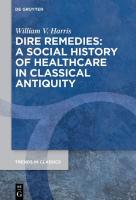
De Gruyter (2024) h/b 601pp £136.50 (ISBN 9783111454399)
The ancient Greeks were said to have invented philosophy. If they did, it was in the sense that they wanted to explain every phenomenon in the natural world in terms of human understanding, without reference to gods. That was an intellectual revolution of the highest order, and one in which ancient doctors played an important part. Their most influential medical theory was that the health of the human body depended on the proper mixture of earth, air, fire (i.e. heat) and water. Why those four elements? Perhaps because without any one of them human life would be impossible.
But if that is what doctors thought, it was not necessarily what the layman thought. Belief in the existence of gods that intervened in human life and needed worship was effectively universal, as the state recognised in its many rituals, especially those relating to the fruitfulness of the natural world. This is where H.’s book comes in. We know a great deal about the doctors’ views of health and sickness, because many of them wrote books about it. But what did everyman make of the doctor’s offerings?
That is the task which H. has set himself, and a very complex task it is too because there is no ancient sourcebook on the matter. The problems that causes, and the immense amount of reading that an attempt at an answer entails, are clear both from the copious footnotes with comments at the foot of every page of the book (well done, de Gruyter!), and the fifty-five page index librorum. H. is also well aware that, however clearly he writes, the sheer volume of matter and the arguments it generates do not make for an easy read. He is therefore punctilious about summarising his main conclusions at the end of each chapter and providing a general conclusion to the whole volume at the back.
The book consists of sixteen chapters, each split into anything from four to fifteen subsections, with a conclusion, the sixteenth being a summarising conclusion of the whole volume. The chapters cover pathologies; doctors’ limitations (e.g. their commitment to the four-element theory); amateur healthcare (drug sellers, oracles, astrology); pain and analgesics (opium and mandragora, which Romans understood better than Greek. One wonders if alcohol could have helped); contagion (understood by lay people, but not doctors, tied to their theories); disgusting medications (animal and human excrement); doctors refusing treatment (it was bad for their reputation if patients died under their care); abortion (not encouraged, presumably for demographic reasons); doctor-prophets (many favouring astrology); seeking help from gods and heroes (very popular in times of serious danger, especially childbirth); Asclepius (incubation—sleeping in a sacred place in the hope of a dream cure—was very popular, especially in Roman times; Asclepius was always seen to be a friend of humans); religion (doctors wanted to protect their reputation for ‘rational medicine’, but the advent of Christianity with its miracle cures turned them into heretics); protective amulets (very common with children and women especially at childbirth, which Christianity appropriated by suggesting that e.g. you tie a copy of a gospel to your head if you had a headache); mental disorders (doctors had no answer to that, and one’s best bet was to be looked after by kindly laypeople, otherwise beggary was the only option); and ancient hospitals (Christian ‘hospitals’ from the 5th C AD onwards were more like almshouses; doctors were not needed because Christ was the supreme healer). Throughout, W. does his best to construct a timeline of the rises and falls in the popularity of medical procedures, but agrees that the evidence is often too thin to be definitive in many cases.
His concluding thought makes a very important point: ‘In order to enter further into the social history of Greek and Roman healthcare we most emphatically need to study the thought processes and emotions that guided their conduct. Much has been done but much remains to be done.’
H. is to be warmly congratulated on a heroic endeavour, at whose scope this review can merely hint. Each chapter, and sometimes each subsection, is almost a thesis in itself, and could surely provide the basis for much more work on a fascinating topic. Given that the doctors’ efforts were largely useless and sometimes actively harmful, one wonders whether the intellectual classes who seemed more inclined to pay attention to them would have been better off had they followed the practises of everyman, many of whom could not afford the doctor’s fees and anyway preferred granny’s nostrums, given that granny must have survived them.
Peter Jones
